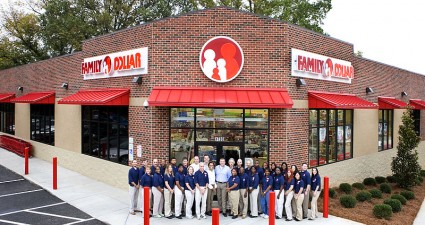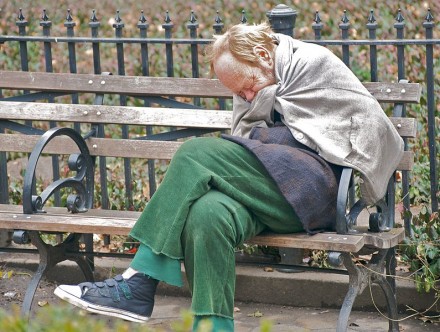 There are two very different Americas today. In one, the stock market is soaring, high end homes are selling briskly, big banks and hedge funds are rolling in money as if the last financial crisis never even happened, and life is really, really good. In the other America, good jobs are incredibly scarce, incomes are declining, and poverty is skyrocketing to levels that we have never seen before. The gap between the wealthy and the poor in America is getting wider with each passing day. In fact, it is my contention that the U.S. has an even larger gap between the rich and the poor than Downton Abbey does. If you have never seen Downton Abbey, you really should. It is one of the most extraordinary shows to appear on television in years. It is a drama set in the UK which follows the lives of the aristocratic Crawley family and their servants throughout the early part of the 20th Century. It can be a bit jarring to watch servants wait on their masters hand and foot and refer to them by such titles as “Lord” and “Lady”, but the truth is that in many ways there is more inequality today than there was back then. As far as people living in the worst areas of cities such as Detroit and Cleveland are concerned, the socialites that live on Fifth Avenue in New York City or in multi-million dollar homes out in the Hamptons might as well be from another planet. If you have lots of money, America is still a really great place to live. If you barely have any money, America can be really cold and cruel. Sadly, our politicians continue to pursue policies that make things even better for those working for the establishment in places such as Washington D.C. and Manhattan, and worse for all the rest of us. This has especially been true over the course of the past four years. If nothing is done, the gaping chasm between the rich and the poor will continue to get even worse, and in the end that will have some really severe consequences for our society.
There are two very different Americas today. In one, the stock market is soaring, high end homes are selling briskly, big banks and hedge funds are rolling in money as if the last financial crisis never even happened, and life is really, really good. In the other America, good jobs are incredibly scarce, incomes are declining, and poverty is skyrocketing to levels that we have never seen before. The gap between the wealthy and the poor in America is getting wider with each passing day. In fact, it is my contention that the U.S. has an even larger gap between the rich and the poor than Downton Abbey does. If you have never seen Downton Abbey, you really should. It is one of the most extraordinary shows to appear on television in years. It is a drama set in the UK which follows the lives of the aristocratic Crawley family and their servants throughout the early part of the 20th Century. It can be a bit jarring to watch servants wait on their masters hand and foot and refer to them by such titles as “Lord” and “Lady”, but the truth is that in many ways there is more inequality today than there was back then. As far as people living in the worst areas of cities such as Detroit and Cleveland are concerned, the socialites that live on Fifth Avenue in New York City or in multi-million dollar homes out in the Hamptons might as well be from another planet. If you have lots of money, America is still a really great place to live. If you barely have any money, America can be really cold and cruel. Sadly, our politicians continue to pursue policies that make things even better for those working for the establishment in places such as Washington D.C. and Manhattan, and worse for all the rest of us. This has especially been true over the course of the past four years. If nothing is done, the gaping chasm between the rich and the poor will continue to get even worse, and in the end that will have some really severe consequences for our society.
So is the answer to raise taxes and “redistribute” more money to the poor? Of course not. Today, we are already paying dozens of different kinds of taxes every year and the government is handing out more money to people than ever before. But poverty just continues to explode.
What the poor in the U.S. desperately need are good jobs, but we continue to ship millions of good jobs out of the country and Barack Obama continues to pursue policies that are killing the U.S. economy.
There is not much help on the horizon for the poor or the middle class in America, and that should be distressing for all of us.
But things in the wealthy parts of America are going absolutely wonderfully right now. Let’s take a few moments and contrast what life is like in the two Americas right now…
In the “good America”, stocks are absolutely soaring. In fact, the S&P 500 closed above 1,500 on Friday for the very first time in more than five years.
In the “bad America”, poverty statistics just continue to get worse. According to a newly released report, 60 percent of all children in the city of Detroit are living in poverty.
In the “good America”, hedge funds are rolling in the profits. The Dow just had its best January since January of 1994, and many analysts are projecting that 2013 will be a banner year for the markets.
In the “bad America”, median household income has fallen for four years in a row, and millions of families are really struggling to find a way to pay the bills each month.
In the “good America”, expensive homes are selling at a pace that we have not seen in years. Just check out what is happening in the Hamptons. According to the National Association of Realtors, sales of homes worth at least a million dollars were 51 percent higher in November 2012 than they were in November 2011.
In the “bad America”, there are hordes of young adults that cannot find jobs and cannot take care of themselves. Shockingly, U.S. families that have a head of household that is under the age of 30 have a poverty rate of 37 percent.
In the “good America”, the “too big to fail” banks are partying like it was 2005 again. For example, revenues at Goldman Sachs increased by about 30 percent in 2012 and Goldman stock has soared by more than 40 percent over the past 12 months.
In the “bad America”, poverty is exploding and government dependence has become a way of life. If you can believe it, the number of Americans on food stamps has grown from about 17 million in the year 2000 to more than 47 million today.
In the “good America”, those working for the establishment will do just about anything to make a buck. For instance, Goldman Sachs made 400 million dollars driving up food prices in 2012 while hundreds of millions around the world existed on the edge of starvation.
In the “bad America”, millions of families are wondering how they will make it until next month. If you can believe it, more than a million public school students in the United States are homeless. This is the first time that has ever happened in our history.
In the “good America”, everyone has a good ride. In fact, sales of luxury German-made vehicles set new all-time records in 2012.
In the “bad America”, those that have lost everything are shunned and ostracized. In fact, many communities all over America are actually making feeding the homeless illegal.
The fact that there is poverty in America should not alarm you. Every country in the world has poverty. What should alarm you is how rapidly it is growing. Even though the Obama administration tells us that we are in an “economic recovery”, things just continue to get worse. The wealthy elitists in Washington D.C. and New York City may be doing wonderfully, but the truth is that the middle class continues to shrink and just about every poverty statistic that you can think of continues to rise.
If you are convinced that we do not have a “wealth gap” problem in the United States today, just check out the following statistics. Most of them are from one of my previous articles entitled “The Middle Class In America Is Being Wiped Out – Here Are 60 Facts That Prove It“…
-According to the Economic Policy Institute, the wealthiest one percent of all Americans households on average have 288 times the amount of wealth that the average middle class American family does.
-In the United States today, the wealthiest one percent of all Americans have a greater net worth than the bottom 90 percent combined.
-According to Forbes, the 400 wealthiest Americans have more wealth than the bottom 150 million Americans combined.
-The six heirs of Wal-Mart founder Sam Walton have as much wealth as the bottom one-third of all Americans combined.
-At this point, the poorest 50 percent of all Americans collectively own just 2.5% of all the wealth in the United States.
-The United States now ranks 93rd in the world in income inequality.
-The average CEO now makes approximately 350 times as much as the average American worker makes.
-Today, corporate profits as a percentage of U.S. GDP are at an all-time high, but wages as a percentage of U.S. GDP are near an all-time low.
Sometimes, when the “good America” and the “bad America” collide, the results are quite humorous.
For example, a 23-year-old homeless Brazilian man and his friends recently decided to “move in” to a 7,522 square foot house down in Florida that is valued at $2.1 million. The following is from a recent article in the Orlando Sentinel…
Bank of America has filed to evict nine squatters from a $2.5-million mansion in a posh Boca Raton neighborhood.
In a filing in Palm Beach County court that names 23-year-old Andre De Palma Barbosa and eight other unknown people, the bank claims rightful ownership of the home – despite Barbosa’s attempt to stake his claim on the foreclosed waterside property by using an obscure Florida real estate law.
Barbosa has been invoking a state law called “adverse possession,” which allows someone to move into a property and claim the title – if they can stay there seven years.
A signed copy of that note is also posted in the home’s front window.
Yeah, they will be able to get him and his friends out of there eventually, but in future years I fear that the conflicts between the rich and the poor will not be so nice.
Already, a very ominous “Robin Hood mentality” is building among the poor in this country. Many wealthy people don’t even realize that it is happening. But someday when desperate “flash mobs” are roaming through their neighborhoods looking to do a little “creative redistribution”, then they will get it.
Our society is starting to come apart at the seams, and there is an incredible amount of tension between the rich and the poor. This is unfortunate, but instead of calming things down many of our politicians are actually exploiting this tension.
When our economy crashes, the class warfare of today may actually turn into real war in the streets. Desperate people do desperate things, and when people are hungry and they can’t feed their families, many of them will not be afraid to go over to the wealthy neighborhoods and take what they want.
A lot of people don’t want to see them, but dark clouds are building. According to a recent Gallup poll, Americans are more negative about where America will be five years from now than they have ever been before. Most people know that we are on the edge of something really bad, even if they can’t really explain it.
It is time to get ready for what is coming. Even though the stock market is soaring right now, that could change at any moment. All of the long-term economic and societal trends are pointing to some really bad things in the years ahead, and sticking our heads in the sand and pretending that everything is going to be okay somehow is not going to help.
So what do you think about all of this?
Do you think that the U.S. has an even larger gap between the rich and the poor than Downton Abbey does?
Please feel free to post a comment with your thoughts below…




